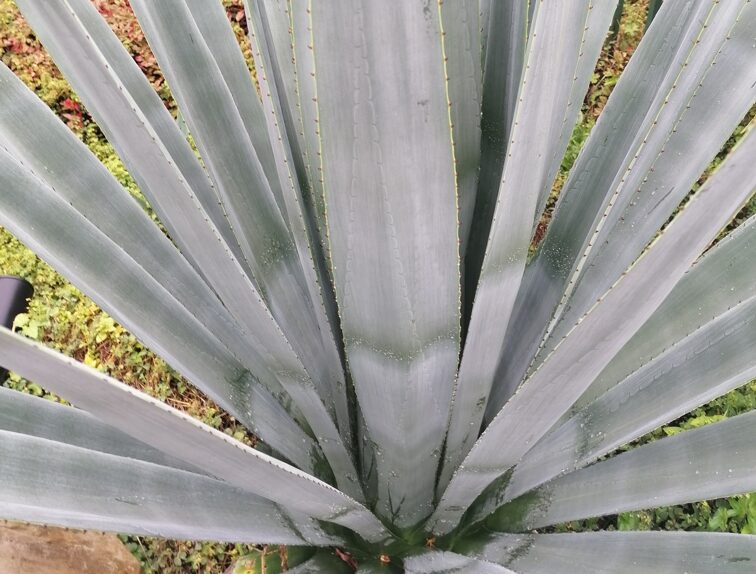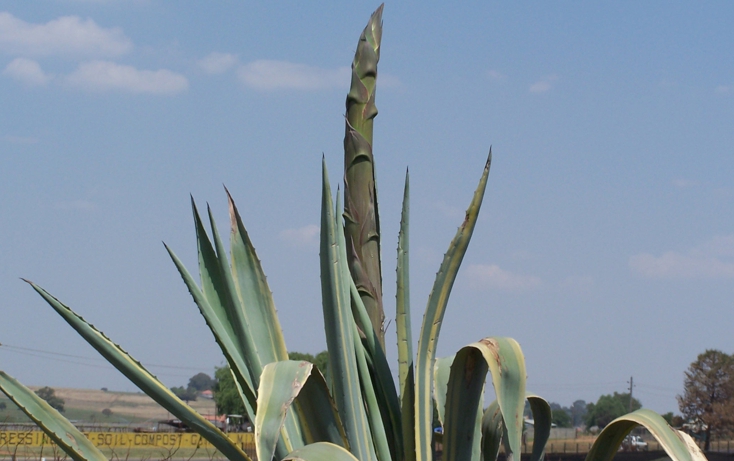Although many species of “orphan” plants are indigenous, there are some which are not.
However, they will grow readily in South Africa, and hold great potential for harvesting and producing a variety of edible or medicinal products.
Central American
One such, indigenous to Central America, specifically Mexico, is Tequila Agave (Agave tequilana var ‘Azul‘).
According to Mexican law only one cultivar, or clone, of one species of Agave, can be used to produce the fiery distilled spirit known as “Tequila”. All other Agave derived spirits are known as “Mezcal”.
It’s considered a class difference, and for a very good reason: no other Agave species produces the levels and purity of sugars needed for brewing and distillation, in the amount of time that this plant does.
Blue Agave
This is the true “Blue Agave”, and it thrives in South African conditions. In recent years a fledgeling agave industry has sprung up in the Little Karroo around Graaff Reinet, and South African-distilled “agave spirit” is sometimes seen in South African bottlestores.

But, although the South African agave spirit industry is doing well, up to this point it has depended on different species in the genus, and one hopes that enterprising smallholders and craft brewers will begin growing and using the “real deal” in coming years.
Thrives on neglect
Large and imposing, this extremely blue leafed and spikey plant thrives on neglect. It can be included in multicropping, used as a security barrier (it was once mooted as a possible solution to curb illegal immigration across South Africa’s porous northern border), planted on retaining walls etc.
It requires no supplemental irrigation in all but the driest areas of South Africa. It is entirely sterile, so cannot set seed. Therefore it can be considered non-invasive.
It also can tolerate the cold encountered in most areas of the country.
Agave heart or core
The usable part of the plant is its “heart” or core. If suckers are consistently removed this ‘pina’ can weigh up to 200kg and produce enough ‘aguamiel’, or “honeywater”, to produce three to five bottles of tequila.
Cut off the flower spike
If the plants are allowed to clump, rotation is faster, but the pina are much smaller. An important part of producing quality agave hearts is to cut off the flower spike. This emerges after five to eight years, a few months before harvest. This allows sugar levels to reach very high levels.
Propagation
Plants are propagated from suckers and bulbils formed on a mature flower spike.
This plant is clonal, and it is important to buy from a verified source as the species and cultivar is very important. It is still rare in cultivation in South Africa.
Market potential
A huge potential market exists for both the final products of this plant (tequila), but also properly processed and dried mature agave heart. This is currently imported at high prices per kilogram for brewing purposes.
Agave spirit is a unique product, and South Africa has the climate and the knowhow to become renowned on the international market, particularly if we use the acknowledged best cultigen, the true tequila plant, Agave tequilana var ‘Azul’.
For more information contact Jason Sampson at jason.sampson@up.ac.za.
Main image: The young flower spike of an agave plant resembles a giant asparagus. Picture: SA Smallholder Online


I am looking for projects and land with blue agave on it in south africa
+27794910225
Good day. Do you sell blue agave?